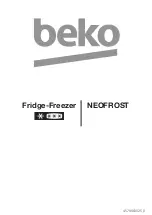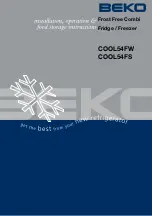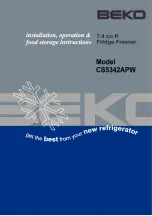
EXTERNAL CLEANING
Wash the outer cabinet with warm soapy water. Do NOT use abrasive products.
WHEN NOT IN USE
Disconnect the appliance from the electricity supply. Remove all goods from the freezer. Clean the freezer as described above. Leave the lid
slightly open.
IF YOUR FREEZER DOES NOT FUNCTION SATISFACTORILY
Check the following before calling for service staff:
ed b
y
Océ-Hungária Kf
t. 2005. 0
7
. 1
4
.
Defect:
Freezer not
cold enough
Too much frost
formed
Check if:
Temperature of stored
foods increases
(becomes hoter).
Lid does not close
completely
Lot of moisture in the
room
Goods packed poorly
Possible cause:
Plug not connected correctly
Defect in switch or fuse
Power failure
Lid in contact with goods in free-
zer
Moisture from washing machine,
tumble-dryer, etc.
Lot of moisture from goods
Action:
Check plug and socket
Check fuse, call electrician
Wait until current returns
Re-arrange goods, check that lid closes
correctly
Move freezer to a room with less moistu-
re, or air regularly
Re-pack goods, see under “How to use”
If you are still unable to solve the problem, summon the assistance of authorised service staff. Do not take any other steps. Incorrect procedure
may cause personal injury or lead to additional defects. It is quite normal for the freezer to seem warm on the outside occasionally, owing to the
heat generated by the freezing process. This heat also helps to prevent the formation of moisture on the outside of the appliance which could
cause rust. If the freezer has been switched off briefly, the compressor may not start immediately when the current is re-connected. This is quite
normal.
IN THE CASE OF A POWER FAILURE OR BREAKDOWN
The hold-over period mentioned in the "Technical Specification" section of this book refers to an estimated time the freezer temperature will take
to rise to an unacceptable level for keeping frozen foods.
Providing the period of power failure or breakdown does not exceed the hold-over period there will be no risk of damage to the frozen food, pro-
viding you do not open the lid during this period.
If the freezer is only half full or the lid is opened this will reduce the hold-over time.
After the breakdown period you are recommended to check the condition of food to ensure it has not started to thaw. Frozen food must NOT be
re-frozen once it has thawed out. The following guidelines should assist you.
Ice cream:
Once thawed should be discarded.
Fruits & Vegetables:
If soft should be cooked and used up.
Breads & Cakes:
Can be re-frozen without danger.
Shellfish:
Should be refrigerated and used up quickly.
Cooked Dishes:
ie. casseroles should be refrigerated and used up.
Large Pieces of Meat:
Can be re-frozen providing there are still ice crystals remaining within them.
Small Joints:
Should be cooked and can then be re-frozen as cooked dishes.
Chicken:
Should also be cooked and re-frozen as a cooked dish.






















